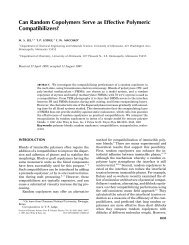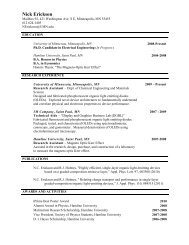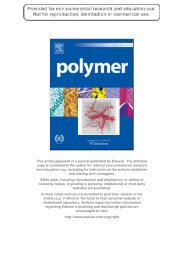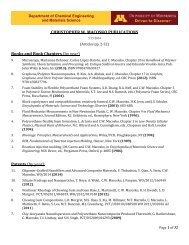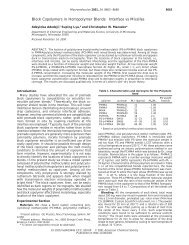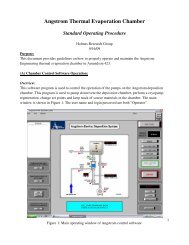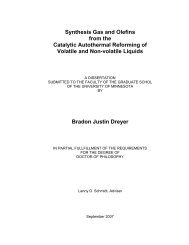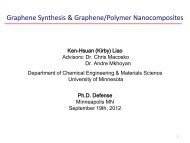Shearing of Polymer Drops with Interface Modification - Unit's home ...
Shearing of Polymer Drops with Interface Modification - Unit's home ...
Shearing of Polymer Drops with Interface Modification - Unit's home ...
You also want an ePaper? Increase the reach of your titles
YUMPU automatically turns print PDFs into web optimized ePapers that Google loves.
6270 Macromolecules 1999, 32, 6270-6277<strong>Shearing</strong> <strong>of</strong> <strong>Polymer</strong> <strong>Drops</strong> <strong>with</strong> <strong>Interface</strong> <strong>Modification</strong>Leon Levitt † and Christopher W. Macosko*Department <strong>of</strong> Chemical Engineering and Materials Science, University <strong>of</strong> Minnesota,Minneapolis, Minnesota 55455Received September 22, 1998; Revised Manuscript Received May 24, 1999ABSTRACT: The influence <strong>of</strong> block copolymers (BCP) and interfacial reaction on the deformation <strong>of</strong> 30-100 µm polymer drops inside an immiscible polymer matrix was visualized in a parallel plate,counterrotating apparatus. Symmetric diblock copolymers were blended into polypropylene (PP),poly(methyl methacrylate) (PMMA), and polyethylene (PE) homopolymers. These were dispersed as dropsin a polystyrene (PS) matrix. Addition <strong>of</strong> BCP significantly increased the amount <strong>of</strong> area the deformingdrop generates when subjected to simple shear flow. <strong>Polymer</strong>s <strong>with</strong> terminal amine groups (PMMA andPS) were coupled <strong>with</strong> maleic anhydride functional PS and PE. This reaction results in the formation <strong>of</strong>graft copolymer at the interface. These reactive pairs appear to be even more effective than BCP atgenerating interfacial area. The enhancement in area may be attributed to reduction in interfacial tensionor to reduction in slip, but more likely a combination <strong>of</strong> both and a gradient in interfacial tension.IntroductionDrop deformation is important for understanding howthe morphology develops in immiscible polymer blends.For example, if drops <strong>of</strong> an impermeable minor phaseare stretched into sheets or platelets, barrier properties<strong>of</strong> the matrix can be improved dramatically. 1 In thispaper we observe molten polymer drops as they aresheared <strong>with</strong>in an immiscible matrix. In previousvisualizations viscosity was low enough that interfacialtension caused the deformed drops to maintain approximatelya circular cross-section. 2-4 Previous analyseshave used this observation to assume symmetryand thus reduce computation to a two-dimensionalproblem. 2,4-6 The viscosity <strong>of</strong> molten polymers is so high,typically >1000 Pa‚s, that interfacial tension has littleeffect on the initial shear deformation <strong>of</strong> drops <strong>with</strong> 50µm or greater diameter. Such drops deform to anellipsoid (see Figure 1) affinely <strong>with</strong> the matrix, i.e., thelength increasing proportional to strain and the widthremaining constant. We have even observed width toincrease due to normal stresses in the matrix. 7However, at large deformation, curvatures becomevery high and interfacial forces win out. Width beginsto contract, and the length stops increasing. Edges mayeven pinch <strong>of</strong>f or the drop break up via Rayleigh-typeinstability. To create polymer blends <strong>with</strong> a high diffusionbarrier, we want the drops to deform into very longand wide platelets. The goal is to significiantly increasethe cross-sectional area <strong>of</strong> the minor phase in the plane<strong>of</strong> shearing. Adding block or graft copolymers to theminor phase should reduce interfacial tension andinterfacial slip. The goal <strong>of</strong> this study is to test theeffectiveness <strong>of</strong> this strategy. We have used both premadediblock copolymers and graft copolymers createdby reaction across the interface. Their effectiveness wasmeasured in terms <strong>of</strong> area generation during shearvisualization.Experimental SectionPairs <strong>with</strong> Block Copolymers. The list <strong>of</strong> materials used<strong>with</strong> premade block copolymers is given in Table 1. Viscoelastic* To whom correspondence should be addressed.† Current address: 3M Center/CRPTL, 208-1, St. Paul, MN55144.Figure 1. Schematic drawing <strong>of</strong> a stretching drop. The dropis approximated as an ellipsoid <strong>with</strong> three radii: R 1, R 2, andR 3.properties, η* and G′ measured <strong>with</strong> 25 mm parallel plates ina Rheometrics RMS at 1 rad/s and 200 °C, are also given. Twopolypropylenes <strong>with</strong> melt indices 2 and 30 (PP2 and PP30)were obtained from Huntsman Chemical Co. Polystyrene (PS)homopolymer, Styron 666D, and high-density polyethylene(PE) were provided by Dow Chemical Co. Poly(methyl methacrylate),PMMA, is from Rohm & Haas.All three block copolymers (BCP) had one PS block and weresynthesized at the University <strong>of</strong> Minnesota. P(S-b-EE) is asymmetric copolymer (50 wt % polystyrene) <strong>with</strong> one blockcontaining, randomly, 70% ethyl ethylene (hydrogenated 1,2-butadiene) and 30% ethylene (hydrogenated 1,4-butadiene),and the other block was PS. Both blocks have molecular weight<strong>of</strong> 50 000, <strong>with</strong> narrow molecular weight distribution: M w/M n ) 1.05. 8 Bates et al. have shown that the EE block <strong>of</strong> thisBCP is miscible in polypropylene. 8 The other two copolymerswere P(S-b-MMA) 9 <strong>with</strong> M w ) 85 000, and P(S-b-E) <strong>with</strong>M w ) 40 000. 10 Both BCPs were also symmetric <strong>with</strong> narrowmolecular weight distributions. Each BCP was first mixed at10% into a homopolymer, as shown in Table 1, and then usedto form drops in the PS matrix, as indicated in Table 2.For the block copolymer to provide effective coupling betweenthe phases each block should be longer than themolecular weight between entanglements, M e. 11 Fetters et al. 12report M e for PS is 13 000. M e for PEE is 11 000, for PMMA is4700, and for PE is 1250. 12-14 Thus all the blocks exceed M e.Reactive Pairs. The list <strong>of</strong> reactive polymers and theirrheological properties is given in Table 3. Three nonreactive10.1021/ma9814999 CCC: $18.00 © 1999 American Chemical SocietyPublished on Web 09/01/1999
Macromolecules, Vol. 32, No. 19, 1999 <strong>Shearing</strong> <strong>of</strong> Modified <strong>Polymer</strong> <strong>Drops</strong> 6271Table 1. Properties <strong>of</strong> Homopolymers, Block Copolymers, and Their Blends at 200 °Cpolymer (abbreviation)M w (supplier)η*, Pa‚sω ) 1s -1G′, Paω ) 1s -1Γ, mN/n<strong>with</strong> PSHomopolymerspoly(methyl methacrylate) (PMMA) 110 000 (Rohm & Haas) 43 000 16 800 1.5 22,280.8 25polyethylene (PE) 160 000 (Dow Chemical) 1 610 273 4.7 25,264.9 33polystyrene (PS) 100 000 (Dow Chemical) 4 940 1730 -1 070 a 185 apolypropylene, melt index 2 (PP2) ∼100 000 (Huntsman) 4 720 a 220 a 4.5 25,27polypropylene, melt index 30 (PP30) ∼50 000 (Huntsman) 854 121Block CopolymersP(S-b-EE) 100 000 (ref 8)P(S-b-MMA) 85 000 (ref 9)P(S-b-E) 40 000 (ref 10)Blends (10% BCP)PMMA + P(S-b-MMA) 30 500 12 600PE + P(S-b-E) 1 630 320PP2 + P(S-b-EE) 3 000 a 850 aPP30 + P(S-b-EE) 545 67a Measured at 220 °C.Table 2. <strong>Drops</strong> <strong>with</strong> and <strong>with</strong>out Block Copolymer in PS Matrixdrop initial diam, µm η r G′ r γ˘ ,s -1 Amax r γ max R 2, a µmPP30 90 0.2 0.07 0.9 4 6 11PP30 + P(S-b-EE) 95 0.1 0.04 1.1 18 22 2.6PP2 120 4.4 11.9 0.9 4 9 15PP2 + P(S-b-EE) 110 2.8 4.6 1.15 9 16 6PMMA 60 8.7 9.7 0.95 4 8 7.5PMMA + P(S-b-MMA) 32 6.2 7.3 1.0 6.5 11 2.5PE 65 0.3 0.2 1.2 5 9 6.5PE + P(S-b-E) 55 0.3 0.2 1.4 8 17 3.4a R 2 (drop thickness/2) at γ max .polymer (abbreviation);trade nameTable 3. Properties <strong>of</strong> Reactive <strong>Polymer</strong>s at 220 °CM w (supplier)η*, Pa‚sω ) 1s -1G′, Paω ) 1s -1reactivitypolyethylene (PE-MA); Polybond 110 000 (Uniroyal) 1900 570 4.5% maleic anhydride (graft)polypropylene (PP-MA) 30 000 (Elf Atochem) 110 80 1% maleic anhydride (graft)poly(methyl methacrylate) (PMMA27) 27 000 (ref 9) 4500 350 nonreactivepoly(methyl methacrylate) (PMMA-NH 2) 29 000 (<strong>Polymer</strong> Source) 3400 270 aliphatic amine (end functional)polystyrene (PS23) 23 000 (ref 15) 45 30 nonreactivepolystyrene (PS-NH 2) 23 000 (ref 15) 100 110 amine (end functional)polystyrene (PS-OX); RPS ∼100 000 (Dow) 1450 260 1% oxazoline (random copolymer)polystyrene (PS-MA); Dylark ∼100 000 (Arco) 1600 250 5% maleic anhydride (random copolymer)5.0 28polymers were also used in the study. Poly(methyl methacrylate),PMMA27, <strong>with</strong> M w ) 27 000 was prepared by means<strong>of</strong> anionic polymerization. 9 Polystyrene, PS23, <strong>with</strong> M w )23 000 was prepared by living radical polymerization andprovided by DeSimone and co-workers. 15 The polypropyleneis PP30; see Table 1. Reactive materials include polymers <strong>with</strong>amine, maleic anhydride, or oxazoline groups. Aliphatic amineterminated poly(methyl methacrylate), PMMA-NH 2, was obtainedfrom <strong>Polymer</strong> Source Co. (Montreal). The polymer hasM w ) 29 000 and a polydispersity, M w/M n, <strong>of</strong> 1.05, as expectedfor anionic polymerization. Ninety-four percent <strong>of</strong> the chainsare terminated <strong>with</strong> an amine group. The other aminefunctionalpolymer was polystyrene (PS-NH 2) <strong>with</strong> M w )23 000 and a polydispersity <strong>of</strong> 1.16. 15 Both PMMA-NH 2 andPS-NH 2 have an aliphatic amine terminal group which is veryreactive toward anhydride. 16All three polymers <strong>with</strong> maleic anhydride (MA) havemultiple functionality <strong>with</strong> various contents <strong>of</strong> MA. Polybond(PE-MA), a low density polyethylene, <strong>with</strong> grafted MA groupswas obtained from Elf Atochem and has functionality <strong>of</strong> 4.5wt %. Low molecular weight polypropylene (PP-MA) is also agraft copolymer from Elf Atochem and has about 1 wt % MAgroups. The PS-MA is a random copolymer (Dylark, ArcoChemical) which contains 5 wt % MA. PS-OX is 1 wt %oxazoline functional polystyrene copolymer obtained from DowChemical. <strong>Polymer</strong> pairs are listed in Table 4. As mentionedearlier, all reactions are imidation type between amine andMA, except the last pair. In the reaction between PP-MA andPS-OX, oxazoline undergoes a ring opening reaction <strong>with</strong>maleic anhydride. 17,18 Due to multiple functionality <strong>of</strong> bothpolymers the reaction leads to cross-linking at the interface.Sample Preparation. About 10 wt % <strong>of</strong> a block copolymerwas blended into each homopolymer using a miniature cupmixer (CSI Co. Sterling Heights, NJ) described in detail bySundararaj et al. 19 About 50 mg <strong>of</strong> BCP powder was added to0.5 g <strong>of</strong> homopolymer and then mixed at 200 °C for 10 min.To improve distributive mixing, the rotor was lifted everyminute. After blending, a thin fiber was drawn from the corner<strong>of</strong> the cup, where the highest shear rate, and thus best mixing,is expected.Thin fibers <strong>of</strong> the polymer selected to be the droplet phasewere prepared by drawing the melt from a heated stage(Mettler, FP80 HT). The temperature <strong>of</strong> the hot stage wascontrolled at 200 °C. The matrix was prepared in the form <strong>of</strong>31 mm diameter, 1 mm thick disks using a heated press. Thefibers were placed in the visualization apparatus between two
Macromolecules, Vol. 32, No. 19, 1999 <strong>Shearing</strong> <strong>of</strong> Modified <strong>Polymer</strong> <strong>Drops</strong> 6273Figure 4. Edge bead in the PP30/PS pair. (a) This is an undeformed drop. (b) About 25% widening is observed at γ ≈ 10. (c) Ata higher value <strong>of</strong> strain the ends <strong>of</strong> the drops become pointed, and the edges thicken due to the effects <strong>of</strong> interfacial tension.Another possible source <strong>of</strong> error in the estimate <strong>of</strong> theprojected area is drop tilt. For affine deformation the angle θbetween the R 1 drop axis and the flow direction decreases <strong>with</strong>strain 21tan θ ) ( 1 / 2 γ + 1 / 2 [4 + γ 2 ] 1/2 ) -1 (3)For a strain <strong>of</strong> 2 the tilt is 23° and the projected area is just8% smaller than the true area, πR 1R 3. Thus the projectionerror was ignored.ResultsIn drop deformation studies the capillary number, theratio <strong>of</strong> shear stress to interfacial stress, is <strong>of</strong>ten used 2Ca ) ηγ˘ R/Γ (4)where Γ is the interfacial tension. For most dropdeformation visualizations in the literature Ca e 1; i.e.,interfacial stresses are large. <strong>Drops</strong> deform moderatelyand reach an equilibrium shape quickly. For example,Guido and Villone 23 recently showed shear deformation<strong>of</strong> 50 µm diameter. PDMS drops in a poly(isobutylene)matrix <strong>with</strong> η ) 81 Pa‚s. The shear rate was low, givingCa ) 0.2, and steady-state deformation was reached atR 1 /R 0 < 2. <strong>Polymer</strong> melts are much more viscous and,as Figure 3 indicates, deform extensively. In this workCa = 50. In some processing flows equilibrium shapesmay never be achieved; for barrier films they areundesireable.Materials <strong>with</strong> Block Copolymers. P(S-b-EE) addedto PP2 made a significant difference in the way thepolypropylene drop deformed. Parts a-c <strong>of</strong> Figure 5show an uncompatibilized PP2 drop in PS (η r ) 4.4,G′ r ) 11.9) matrix at strains γ ) 0, 3, 20. G′ r representsthe drop/matrix elasticity ratio, G′ d /G′ m . The dropdeforms like a pointed cylinder. Addition <strong>of</strong> BCP reducesFigure 5. Micrograph <strong>of</strong> PP2 drop <strong>with</strong>out BCP and <strong>with</strong> P(Sb-EE)in PS matrix at 220 °C. (a) This is a noncompatibilizeddrop at γ ) 0. (b) The drop forms a torpedo-like shape whenγ ) 3. (c) γ ) 20. (d) This is an undisturbed PP2 drop <strong>with</strong>10% P(S-b-EE) BCP. (e) A flat shape is formed at γ ) 6.(f) even at γ ∼12 the sheetlike geometry is maintained.interfacial tension but also surprisingly the viscosity(see Tables 1 and 2). 24 A significant increase in projectedarea is observed. The width <strong>of</strong> the platelet in Figure 5fis equal to the diameter <strong>of</strong> the drop even at γ ) 20.In our previous work, it was shown that a more elasticmatrix causes less elastic drops to widen in the vorticitydirection, i.e., perpendicular to the direction <strong>of</strong> flow dueto the second normal stress <strong>of</strong> the matrix. 7 PP30/PS
6274 Levitt and Macosko Macromolecules, Vol. 32, No. 19, 1999Figure 6. Influence <strong>of</strong> BCP on the reduced area generationfor P2 and PP30 drops in PS matrix. PP2 <strong>with</strong>out BCP followsthe affine cylinder deformation. Addition <strong>of</strong> BCP doubles A rat γ ) 15. PP30 drop (η r ) 0.2, G′ r ) 0.07) starts as affine butquickly declines due to interfacial tension, Γ ) 5 mN/m. ThePP30/P(S-b-EE) (η r ) 0.1, G′ r ) 0.04) drop generates an arealarger than affine due to widening caused by matrix normalstresses. 7 There is more than a 4-fold increase in the area.Figure 7. Reduced area for PMMA drops in PS matrix(η r ) 8.7, G′ r ) 9.7, D 0 ) 60 µm) <strong>with</strong> 10% P(S-b-MMA) BCP(η r ) 6.2, G′ r ) 7.3, D 0 ) 32 µm). Although a noncompatibilizeddrop is twice as big as the PMMA drop <strong>with</strong> P(S-b-MMA) BCP,it generates less area.represents such a case; G′ r ) 0.1 indicates that thematrix has much higher normal stresses. As a resultthe width <strong>of</strong> the drop increases (see Figure 4b), untilthe stress from interfacial tension becomes equal to thedifference in normal stresses between the two phases.Figure 6 illustrates area generation for PP2 and PP30drops sheared in the PS matrix <strong>with</strong> and <strong>with</strong>out P(Sb-EE)copolymer. The graphs are compared to affine (eq1) and affine cylinder (eq 2) deformations. The effect <strong>of</strong>BCP is quite evident. The maximum reduced projectedarea for PP2 <strong>with</strong>out compatibilizer is 4. Addition <strong>of</strong> 10%P(S-b-EE) more than doubles A r max . The lower viscosityPP30 <strong>with</strong> 10% <strong>of</strong> the same BCP produces an evenbigger effect when sheared in the same matrix. Thereis a quadruple increase in the reduced area over thenoncompatibilized PP30/PS666. Widening <strong>of</strong> the compatibilizedPP30 drop results in more than affine areageneration.Figure 7 shows results for PMMA drops in a PSmatrix. The drops are much more viscous and elasticthan the PS matrix: η r ) 8.7, G′ r ) 9.7 for the PMMA/PS system, and η r ) 6.2, G′ r ) 7.3 for the PMMA + P(Sb-MMA)/PSpair. Thus, we do not expect any widening,and affine deformation is the limit for A r . Figure 7 andTable 2 show that when the diblock copolymer wasFigure 8. Shear <strong>of</strong> PE drops in PS matrix <strong>with</strong> and <strong>with</strong>outP(S-b-E) copolymer (η r ) 0.3, G′ r ) 0.2). D 0 ) 55 µm <strong>with</strong> and65 µm <strong>with</strong>out.added to PMMA, A r increased more than 50% despitethe fact that the initial drop was much smaller. It shouldbe noted that, according to the analysis <strong>of</strong> Van Oene, 29the drop should not be deforming at all. Van Oeneargued that the difference in normal stresses betweenthe drop and the matrix should be added to the stressfrom interfacial tension. We calculated the normal stressassuming the shear rate inside the drop is the same asthe matrix. The normal stress plus interfacial stress issignificantly bigger than the shear stress exerted by thematrix, yet the drops deform. Also several studies onNewtonian drops have shown that for η r g 4 the dropsshould reach a stable shape and stop deforming. 2-4 Boththe compatibilized and noncompatibilized PMMA dropsexceed this critical ratio.The area generation results in Figure 8 for PE dropsin PS, and those <strong>of</strong> PE + P(S-b-E)/PS are similar to thePMMA results. A r for the drops <strong>with</strong> P(S-b-E) generated60% more area than the uncompatibilized drop, whencompared at A max r .The values <strong>of</strong> R 2 in Table 2 are at the strain causingmaximum area generation. They illustrate the efficiency<strong>of</strong> area generation from a different perspective. Thevalue <strong>of</strong> R 2 , which represents the thickness <strong>of</strong> the drops,is always smaller for the compatibilized pairs. If thedrops are simple ellipses, then 1/R 2 is the maximumcurvature where the maximum interfacial stress isgenerated. At this point interfacial stresses are stoppingfurther area growth. If we put these values into eq 4along <strong>with</strong> γ˘ and PS viscosity and interfacial tensionvalues from Table 1, we calculate a capillary number<strong>of</strong> roughly 10. If we assume that, at about this samevalue <strong>of</strong> the capillary number, area generation shouldreach a maximum for the drops <strong>with</strong> added blockcopolymer, then the ratios <strong>of</strong> R 2 in Table 2 are ameasure <strong>of</strong> the decrease in interfacial tension. Theseratios suggest that block copolymer decreases Γ by afactor <strong>of</strong> 2-3 in all five pairs. Such reductions for 10%block copolymer have been observed. 26Reactive Pairs. A very significant improvement inarea generation was found for the reactive PMMA-NH 2 /PS-MA pair over nonreactive PMMA/PS-MA. The effectis shown in Figure 9. In both cases the drop is moreviscous than the matrix (η r ) 2.8 for nonreactive and2.1 for reactive). The width <strong>of</strong> the stretched reactivedrops almost does not change for the duration <strong>of</strong> theexperiment (γ ) 40), when the sheet <strong>of</strong> PMMA-NH 2became so thin that we could no longer observe it. The
Macromolecules, Vol. 32, No. 19, 1999 <strong>Shearing</strong> <strong>of</strong> Modified <strong>Polymer</strong> <strong>Drops</strong> 6275Figure 9. Reduced area vs strain for the reactive andnonreactive PMMA in PS-MA matrix.Figure 11. Cross-linking reaction between PP-MA drop andPS-OX matrix makes the interface less mobile. As a result nodeformation was observed despite low rheological ratios(η r ) 0.08, G′ r ) 0.3) at γ˘ ) 1s -1 , as shown in (a) γ ) 0 and(b) γ ) 15. The irregular shape <strong>of</strong> the drop is due to thedifficulty in breaking the fiber. Micrographs (c) γ ) 1 and(d) 15 represent the nonreactive PP30/PS-OX case. The dropstretches into a sheet.Figure 10. Reduced area plotted versus strain for nonreactivePS23/PE-MA (open symbols) and reactive PS-NH2/PE-MA(solid symbols) pairs. As expected, all drops fall on the samecurve at low strain. Reaction at the interface delays themaximum for A r and results in larger interfacial area.reduced area is slightly smaller than affine but followsthe trend to very high strains, as seen in Figure 9. Atγ ) 30, there is more than a 4-fold increase in A r overthe nonreactive case. The difference should increaseeven more <strong>with</strong> strain.Reduced area is plotted in Figure 10 for three nonreactivedrops <strong>of</strong> PS23 <strong>with</strong> diameters 40, 67, and 87µm sheared in PE-MA. These low-viscosity drops (η r )0.02) at small strain, γ < 7, follow affine deformation,and the values <strong>of</strong> the reduced area are the same for allthree. The difference in shear rate between the dropsdue to the difference in radial position in the parallelplates does not exceed 2%. Using the method describedin Figures 2 and 3, the shear rate was estimated to be2.1 s -1 . The maximum in area generation was observedat γ ) 12 for a 40 µm drop and γ ) 20 for 87 µm drop,increasing <strong>with</strong> drop size as expected.In the experiment <strong>with</strong> reactive PS-NH 2 /PE-MA wealso observed three drops. Two <strong>of</strong> them, 40 and 59 µm,are similar in size to the nonreactive ones. The diametersare close, and shear rate was found to be similar,2.3 s -1 . The maximum for a 40 µm reactive drop wassignificantly delayed from 12 to 24 strain units. A moreremarkable improvement was observed for the 59 µmdropsno decline <strong>of</strong> A r until γ = 50.Table 4 summarizes the more efficient area generation<strong>of</strong> the reactive drops. The thickness <strong>of</strong> the PS-NH 2drop (represented by R 2 ) is about half <strong>of</strong> the nonreactiveone. This indicates that the reactively formed graftcopolymer between PS and PE has halved their interfacialtension, using the same argument given above<strong>with</strong> respect to R 2 for block copolymer modified drops.For the PMMA-NH 2 drop in the PS-MA matrix, R 2 forthe reactive and nonreactive pairs indicate Γ is reducedby a factor <strong>of</strong> 5. Such a large decrease in interfacialtension is about the maximum that has been attributedto block copolymers in the literature. 26,30,31Note in Table 4 that regardless <strong>of</strong> their initialdiameter all the nonreactive drops have about the samethickness at the maximum in area generation R 2 * )3-5 µm. The same is true for the reactive drops exceptR 2 * is smaller (=1 µm). This is similar to the results inTable 2 and is another argument for a critical value <strong>of</strong>Ca at maximum area generation, although here Ca* =3 for nonreaction drops compared to roughly 10 for theuncompatibilized polymers in Table 2. Clearly a morecomplete analysis <strong>of</strong> drop deformation would be helpful.Viscosity ratio and elasticity must also be important.Elasticity may cause drops at large deformation to notbe ellipsoidal, e.g., Figures 4c and 5b,c. We are currentlypursuing a full finite element aided analysis <strong>of</strong> viscoelasticdrop deformation. 32The last reactive pair in Table 4 can cross-link dueto multiple fundamental groups on both polymers.Cross-linking has a dramatic effect on the drop/matrixinterface. The PP-MA fiber was very stable after 5h<strong>of</strong>heating inside the PS-OX matrix at 220 °C. Only afterthe fiber was sheared in both directions did it break intoobjects, and these never assumed spherical shape.Further shearing at γ˘ ) 1s -1 had no effect on dropdeformation, as shown in Figure 11a,b. NonreactivePP30, on the contrary formed sheets, as shown in Figure11c,d.Interfacial Tension Reduction, Slip, or TensionGradient?Another explanation for the increase in area generationwhen block copolymers are added or formed by
6276 Levitt and Macosko Macromolecules, Vol. 32, No. 19, 1999interfacial reaction is that, in addition to decreasinginterfacial tension, the copolymers increase adhesion.De Gennes 33 and also Goveas and Fredrickson 34 havepointed out that there must be a reduction in entanglementsclose to the interface between two immisciblepolymers. This leads to much lower viscosity or a sliplayer in the interface. Block or graft copolymers canspan the interface and eliminate the slip layer. 33 ThePS-g-PMMA and PE-g-PS copolymers formed at theinterfaces <strong>of</strong> our drops (Figures 9 and 10) may be <strong>of</strong> veryhigh molecular weight <strong>with</strong> many entanglements acrossthe interface. 20,40In principle it is possible to measure the interfacialtension directly in our apparatus by recording dropretraction after a shear deformation. However, aftercessation <strong>of</strong> shearing the uncompatibilized drops wereunstable, breaking into smaller droplets. This is similarto the observations <strong>of</strong> Yamane et al. 35 By using smallerdeformations, we got stable recovery. We could fit ourlength retraction to the 2D Newtonian analysis <strong>of</strong>Tjahjadi et al., 36 but it required values <strong>of</strong> Γ higher thanthose reported in the literature. Again a 3D viscoelastic,finite element analysis is needed.The compatibilized drops were less prone to breakupand recovered more slowly. The reactive systems showedthe slowest recovery. Stability <strong>of</strong> the platelet structureis also very important for creating barrier films sincein processing drops will experience changing shear andextension rates as well as a recovery period until theyare frozen by cooling below the glass or crystallizationtemperature.For the PS23 and PS-NH 2 drops sheared in the PE-MA matrix we attempted to measure the equilibriumdrop size. After shear was stopped and started severaltimes, only small, short cylinders remained. What wasremarkable is that both the reactive and nonreactivesystems gave the same size cylinders, 7-8 µm indiameter. Sundararaj and Macosko 28 also found nodifference in drop size between block copolymer compatibilizedand uncompatibilized polymer blends atsteady-state mixing in the dilute drop limit. Sondergaardand Lyngaae Jorgenson 37 used light scatteringto measure the increase in aspect ratio <strong>of</strong> PS drops inPMMA <strong>with</strong> a start up <strong>of</strong> shearing. With 2% P(S-b-MMA) the maximum aspect ratio was twice that <strong>with</strong>outblock copolymer; however, both systems went to thesame equilibrium aspect ratio. If block copolymer simplylowers interfacial tension, we expect that in all three <strong>of</strong>these studies the steady-state sizes <strong>of</strong> the drops <strong>with</strong>block copolymer would be smaller. This was not observed.However, if block copolymers reduce slip in theinterface, this should also reduce the steady-state size.Another possiblity is gradients in interfacial tension.In drops <strong>of</strong> small molecule liquids, surfactants areknown to concentrate at the ends <strong>of</strong> a deforming drop,causing a gradient in surfactant concentration. 38,39 Thesame phenomenon seems even more likely when largeblock copolymers are in a deforming interface.Conclusions<strong>Polymer</strong> drop deformation was observed using aparallel plate device <strong>with</strong> counterrotating transparentplates. The influence <strong>of</strong> block copolymers (BCPs) andin situ formed graft copolymers on polymer drop deformationwas studied. It was found that interface modificationhad a pronounced effect on the amount <strong>of</strong> areagenerated during simple shear. The area which a minorphase creates during processing <strong>of</strong> polymer blends is thekey for good barrier properties. The efficiency <strong>of</strong> stretchingis measured in terms <strong>of</strong> reduced area, which is theratio <strong>of</strong> the projected area to the cross-section <strong>of</strong> theinitial drop. These measurements were compared toideal affine and affine cylinder area generation.Addition <strong>of</strong> 10% P(S-b-EE) block copolymer to twogrades <strong>of</strong> polypropylene (melt index 2 and 30) resultedin a 2-fold increase in A r max for PP2 and 4-fold for PP30.BCP broadens the maximum <strong>of</strong> A r and extends it tolonger times, which is important if the morphology hasto be preserved. Widening <strong>of</strong> the drop due to the muchlarger elasticity <strong>of</strong> the PS matrix compared to the PP30drop results in greater than affine deformation. Significanteffects were also found for the PMMA/PS pair <strong>with</strong>P(S-b-MMA) BCP. A small compatibilized drop (32 µm)generated 50% more reduced area than a larger drop(60 µm) <strong>with</strong>out BCP.Reactive PMMA-NH2 exhibits affine deformationeven at high strain γ > 40 when sheared in PS-MAmatrix. It gave nearly a 5-fold improvement in areageneration over the nonreactive PMMA/PS-MA pair,although interfacial tension was relatively small, Γ )1.5 mN/m. Deformation <strong>of</strong> several different size drops<strong>of</strong> reactive polystyrene <strong>with</strong> end-functional amine groupswas compared to similar size drops <strong>of</strong> nonreactive PS.Twice as much area was obtained at the maximum A rfora40µm PS-NH 2 drop. A cross-linked “shell” arounda PP-MA drop sheared in PS-OX matrix prevented thedrop from deforming.The greater deformability <strong>of</strong> drops <strong>with</strong> interfacesmodified by block or graft copolymer may be due toreduction in interfacial tension or reduction in interfacialslip, but is probably a combination <strong>of</strong> these as wellas tension gradients. Measurements and analysis <strong>of</strong>recovery after drop deformation may help to resolve thisquestion and are also important for predicting finalmorphology in laminar blends for barrier films.Acknowledgment. This work was supported by theNational Science Foundation sponsored Center forInterfacial Engineering and grants from DuPont andthe 3M Co. We wish to thank Frank Bates for providingus <strong>with</strong> the P(S-b-EE) block copolymer, Mark Gehlsenfor the P(S-b-E) sample, John DeSimone for the PS-NH 2 , and Russell Hooper and David Morse for helpfuldiscussions.References and Notes(1) Subramanian, P. M. U.S. Patent 4,444,817, 1984; Polym. Eng.Sci. 1985, 25, 483.(2) Taylor, G. I. Proc. R. Soc., London 1932, A138, 41; 1934,A146, 501.(3) Grace, H. P. Chem. Eng. Commun. 1982, 14, 225.(4) Bentley, B. J.; Leal, L. G. J. Fluid Mech. 1986, 167, 241.(5) Rallison, J. M. Annu. Rev. Fluid Mech. 1984, 16, 45.(6) Stone, H. A. Annu. Rev. Fluid Mech. 1994, 26, 65.(7) Levitt, L.; Macosko, C. W.; Pearson, S. D. Polym. Eng. Sci.1996, 36, 1647.(8) Bates, F. S.; Kumar, A.; Schulz, M. J. Polym. Sci., Part B:Polym. Phys. 1995, 33, 1746. Weimann, P. A.; Jones, T. D.;Hillmyer, M. A.; Bates, F. S.; Londono, J. D.; Melnichenko,Y.; Wignall, G. D.; Almdal, K. Macromolecules 1996, 30, 3650.(9) Guegan, P.; Macosko, C. W.; Ishizone, T.; Hirao, A.; Nakahama,S. Macromolecules 1994, 27, 4993.(10) Gehlsen, M. D. Ph.D. Thesis, University <strong>of</strong> Minnesota,Minneapolis, 1994.(11) Creton, C.; Kramer, E. J.; Hadziioannou, G. Macromolecules1991, 24, 1846.(12) Fetters, L. J.; Lohse, D. J.; Richter, D.; Witten, T. A.; Zirkel,A. Macromolecules 1994, 27, 4639.
Macromolecules, Vol. 32, No. 19, 1999 <strong>Shearing</strong> <strong>of</strong> Modified <strong>Polymer</strong> <strong>Drops</strong> 6277(13) Plazek, D. J.; Tan, V.; O’Rourke, V. M. Rheol. Acta 1974, 13,367.(14) Raju, V. R.; Rachapudy, H.; Graessley, W. W. J. Polym. Eng.,Polym. Phys. Ed. 1979, 17, 1223.(15) Peters, M. A.; Belu, A. M.; Linton, R. W.; Dupray, L.; Meye,T. J.; DeSimone, J. M. J. Am. Chem. Soc. 1995, 112, 3380.See also: Polym. Prepr. (Am. Chem. Soc., Div. Polym. Chem.)1993, 34, 374.(16) Orr, C. A.; Adedeji; A.; Hirao, A.; Bates, F. S.; Macosko, C.W. Macromolecules 1997, 30, 1243.(17) Fowler, M. W.; Baker, W. E. Polym. Eng. Sci. 1988, 28, 1427.(18) Liu, N. C.; Baker, W. E. Adv. Polym. Technol. 1992, 11, 249.(19) Sundararaj, U.; Macosko, C. W.; Nakayama, A.; Inoue, T.Polym. Eng. Sci. 1995, 35, 100.(20) Levitt, L. Area Generation in Two-Phase <strong>Polymer</strong> MeltProcessing. Ph.D. Thesis, University <strong>of</strong> Minnesota, Minneapolis,1997.(21) Meijer, H. E. H.; Janssen, J. M. H. Mixing <strong>of</strong> ImmiscibleLiquids. In Mixing and Compounding <strong>of</strong> <strong>Polymer</strong>s; Manas-Zloczower, I., Tadmor, Z., Eds.; Hanser Publishers: NewYork, 1994. See also Macosko, C. W. Rheology: Principles,Measurements and Applications; Wiley VCH: New York,1994; p 36.(22) Sundararaj, U.; Dori, Y.; Macosko, C. W. <strong>Polymer</strong> 1995, 36,1957.(23) Guido, S.; Villone, M. J. Rheol. 1998, 42, 395.(24) Reduction in viscosity <strong>with</strong> as little as 2% BCP has beenobserved. Jones, T. D.; Bates, F. S.; Macosko, C. W. Polym.Prepr. (Am. Chem. Soc., Div. Polym. Chem.), 1999, 40:2, 1097.(25) Wu, S. <strong>Polymer</strong> 1987, 26, 1855.(26) Elemans, P. H. M.; Janssen, J. M. H.; Meijer, H. E. H. J.Rheol. 1990, 34, 1311.(27) Elmendorp, J. J.; de Vos, G. Polym. Eng. Sci. 1986, 26, 415.(28) Sundararaj, U.; Macosko, C. W. Macromolecules 1995, 28,2647.(29) Van Oene, H. J. Colloid <strong>Interface</strong> Sci. 1972, 40, 448.(30) Anastasiadas, S. H.; Gancarz, L.; Koberstein, J. T. Macromolecules1989, 22, 1449.(31) Mekhilef, N.; Favis, B. D.; Carreau, P. J. J. Polym. Sci., PartB: Polym. Phys. 1997, 35, 293.(32) Hooper, R. W.; Macosko, C. W.; Derby, J. J. FEM Modeling<strong>of</strong> Transient Viscoelastic Drop Deformation in ExtensionalFlow. J. Non Newt. Fluid Mech., submitted for publication.(33) De Gennes, P. G. C. R. Acad Sci., Ser. II: Mec., Phys., Chim.,Astron. 1989, 308, 1401. Brochard, F.; de Gennes, P. G.;Troian, S. C. R. Acad Sci., Ser. III: 1990, 310, 1169.(34) Goveas, J. L.; Fredrickson, G. H. Eur. Phys. J. B. 1998, 2,79.(35) Yamane, H.; Takahashi, M.; Hayashi, R.; Okamoto, R.;Kashihara, H.; Masuda, T. J. Rheol. 1998, 42, 567.(36) Tjahjadi, M.; Ottino, J. M.; Stone, H. A. AIChE J. 1994, 40,385.(37) Songergaard, K.; Lyngaae-Jorgensen, J. Rheo-Physics <strong>of</strong>Multiphase <strong>Polymer</strong> Systems; Technomic: Lancaster, PA,1993; p 475.(38) De Bruijn, R. A. Chem. Eng. Sci. 1993, 48, 277.(39) Li, X.-F.; Pozrikidis, C. J. Fluid Mech. 1997, 341, 165.(40) Levitt, L.; Macosko, C. W.; Schweizer, T.; Meissner, J. J.Rheol. 1997, 41, 671.MA9814999




